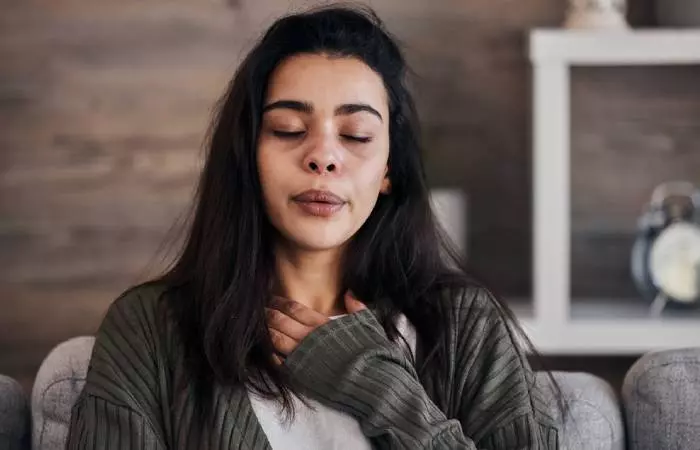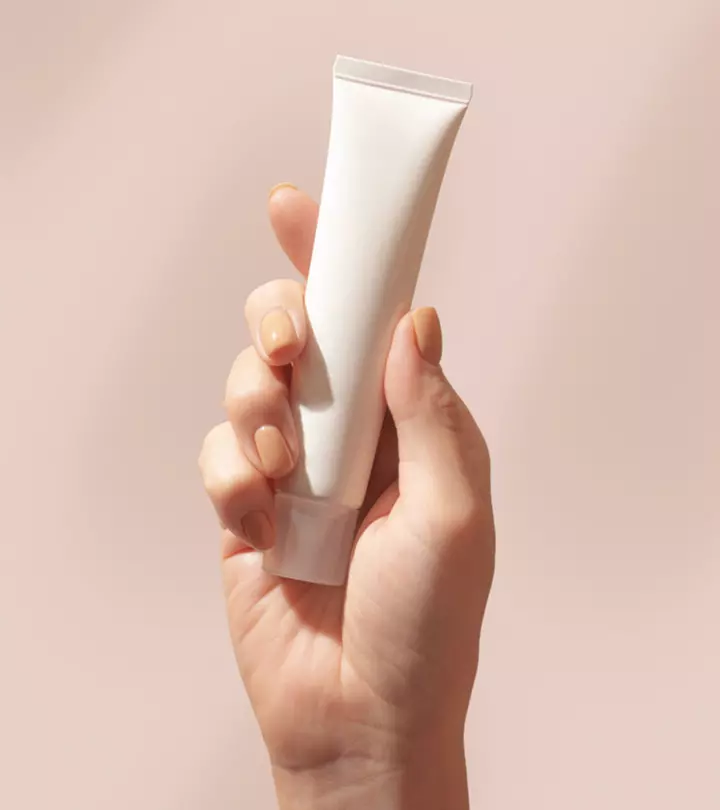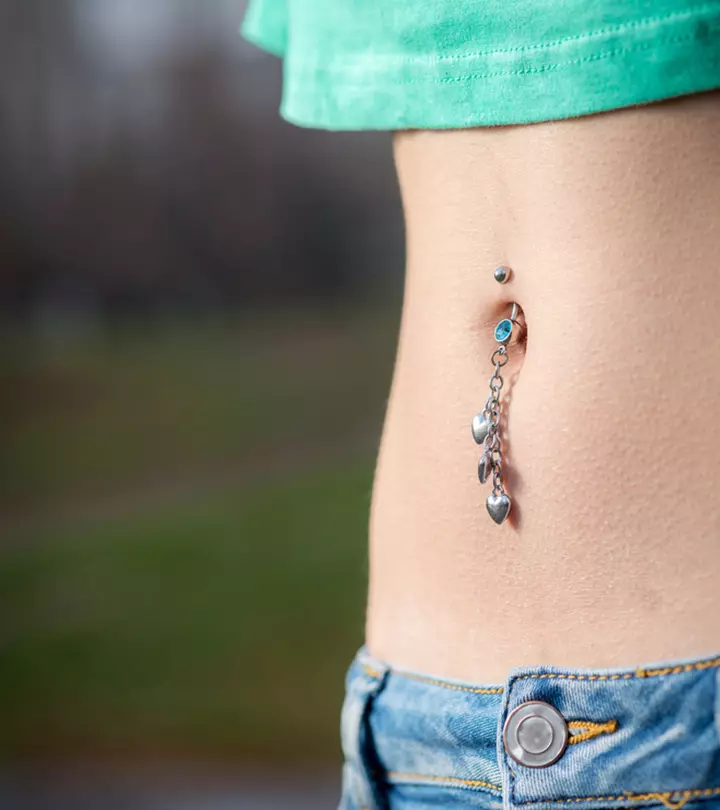Daith Piercing For Anxiety: Does It Really Work?
Dive deep into the truth about its effects beyond the aesthetic appeal.

Image: Shutterstock
Daith piercing runs through the innermost fold of the ear, also called the crux of the helix. While a daith ring adds bling to your ear, it may also help ease your anxiety-related problems. But here is a catch – there are no promises that it will work for you. Moreover, this hard cartilage above the ear canal can make this piercing quite painful for some people. This is why daith piercing requires commitment and care to heal properly before it can start working. Although many people opt for daith piercings in hopes of treating anxiety, it is important to recognize both the anecdotal claims and the scientific doubts surrounding this practice. This article seeks to examine these claims and offer a thorough understanding of the possible risks and factors to consider. Scroll down.
In This Article
Does Daith Piercing Really Help With Anxiety?

There are many types of piercings, and daith piercing is one of them. Currently, there are no clinical studies that directly support the claims of the anti-anxiety effects of daith piercing. However, several people have experienced reduced anxiety and chronic headaches after getting a daith piercing. So, the effectiveness of daith piercing for anxiety is largely anecdotal. Also, there is no way to predict if it will work for you.
 Trivia
TriviaAlthough it may not be effective for everyone, a lot of people still turn to daith piercing in the hope of treating their anxiety. Let us dive deeper into the following section to understand how it possibly works.
Key Takeaways
- Daith piercing for anxiety lacks direct scientific evidence; its effectiveness is largely anecdotal.
- The mechanism of action is linked to acupuncture, targeting pressure points in the ear to potentially calm anxiety.
- No conclusive evidence supports daith piercing as a placebo effect; it needs clinical trials for validation.
- Risks include infection, pain, and nerve damage; thorough consideration and professional advice are crucial before opting for daith piercing.
How Is It Said To Work?
Daith piercings are often linked to acupuncture as they both use a similar mechanism for anxiety treatment. Acupuncture treatment involves inserting thin needles into specific points on the body to stimulate energy flow from the central nervous system. The vagus nerve is the longest of the 10 nerves that extend from the base of your brain into the entire body. Stimulating the vagus nerve reduces fear and calms the nervous system, which helps reduce anxiety (1). Daith piercing is thought to target a similar pressure point in the ear.
So, it is based on the idea that the piercing on this specific spot of daith stimulates pressure points that correspond to anxiety relief and act as a potential treatment for anxiety. But is there any medical evidence to support this claim? Check it out in the next section.
Research Behind Daith Piercing For Anxiety

Many people get Daith piercings for migraines. The science behind it lies in the history of acupuncture. However, there is no related scientific proof to it. Similarly, the effectiveness of using a daith piercing to alleviate anxiety relies mainly on anecdotal evidence, lacking clinical evidence. On the other hand, studies involving ear pressure point therapy have shown improvement in stress and anxiety levels with techniques such as acupuncture and pressure (2).
Studies have shown that daith piercing may temporarily alleviate migraines, but the pain may soon come back after weeks or months (3). However, during the period when it does work, a daith piercing may help reduce the symptoms of anxiety as well since anxiety and stress usually co-exist with migraine (4).
So, what causes these therapeutic effects? Scroll down to know whether it is mind or matter at play.
Is It A Placebo Effect?
The placebo effect occurs when a person experiences positive outcomes due to their belief in the effectiveness of a treatment, even if the treatment itself is inactive or lacks therapeutic properties.
Even to confirm that the benefits of daith piercing for anxiety are nothing but a placebo effect, proper controlled trials are required. Since comprehensive studies are lacking in this area, the anti-anxiety effects of this piercing cannot be fully attributed to the placebo effect.
Moreover, a survey on cluster headaches published in the journal Cureus reveals that patients with migraines benefited from daith piercing (3). Despite this, the study emphasized the lack of scientific literature, which requires further research in this area.
On the other hand, some people reported that it only treated their anxiety temporarily (5). So, presently, the potential benefits of daith piercings for anxiety are based largely on anecdotal evidence with inconsistent results, and it is difficult to conclude whether this is due to a physiological change or just all in the head.
But if it is a possible treatment for anxiety, which ear should you get your daith pierced on? Find out in the next section.
Does It Matter Which Side The Daith Piercing Is On?

There is no specification about which ear you should get your daith pierced for, especially for anxiety. Still, you can consider the following:
- For Migraine Accompanied Anxiety
As per a study, a 47-year-old woman had an immense headache on her left side, which subsided after she got her left daith pierced (3). Soon, the pain came back in the right side of her head, which subsided after she had a right ear piercing. So, if your anxiety is due to a migraine, you can get it done on the side where you feel the most pain.
- For Brain-Related Disorders
According to a study published in the journal Brain Stimulation, stimulation of the vagus nerve through the left ear is highly effective for treating brain-related medical conditions in patients with brain strokes (6). Based on this, a left ear piercing may be considered beneficial for treating brain disorders and their potential symptoms, such as anxiety, stress, and headache.
Please note that none of these studies claim to present daith piercing as a permanent treatment option for people with anxiety issues. In such a scenario, it is important to make a wise decision, as this piercing could also pose several health risks. Read about them in the next section.
Risks Associated With Daith Piercing

In addition to not being effective, a daith piercing may also end up raising other health concerns for you, as follows (7):
- Infection
There are many types of piercings and each one creates an open wound, making them susceptible to bacterial infections. If proper aftercare is not followed, this can lead to severe inflammation and disfigurement of the piercing.
- Pain And Swelling
Daith piercings can be more painful compared to some other ear piercings due to the thickness of the ear cartilage in this region. Swelling is a common initial reaction, but excessive or prolonged swelling may indicate a problem.
- Keloid Formation
Some individuals are prone to keloid formation, an overgrowth of scar tissue. Keloids can be raised, itchy, and may extend beyond the boundaries of the piercing.
- Migration And Rejection
The body may perceive the piercing as a foreign object, leading to migration (movement of the jewelry within the tissue) or rejection (the body pushing the piercing out).
- Bleeding
As with any piercing, there is a risk of bleeding during and after the procedure. However, excessive bleeding or prolonged bleeding should be addressed promptly.
- Allergic Reactions
Some people may be allergic to certain metals used in piercing jewelry, leading to allergic reactions. Common allergens include nickel, which can cause redness, itching, and other skin irritations.
- Nerve Damage
Piercing the cartilage in the ear carries a risk of hitting a nerve, which can result in temporary or permanent nerve damage. This can lead to numbness or an altered sensation in the affected area.
- Poor Healing
such as a daith piercing typically require six to nine months for complete healing, making it a time-consuming ear-piercing process. Poor aftercare, trauma to the piercing, or underlying health issues can impede the healing process.
Clearly, it is important to seek advice from a skilled piercer to ensure the piercing is done correctly. A carefully done piercing helps reduce risks like infection and keloid formation, which are common with cartilage piercings. In addition, you must also follow all the aftercare tips religiously.
 Pro tip
Pro tipMoreover, keep in mind that a daith piercing will cause a permanent hole in the daith region, which will make it very difficult to use that point as an acupuncture point. So, it is better to first try non-invasive therapy such as acupuncture to manage your anxiety or migraine before heading for a piercing.
Getting a daith piercing to reduce anxiety has not been proven by science yet. People may notice a reduction in their symptoms initially and feel better, but the piercing can cause problems like infections or pain. The idea behind its effects is similar to acupuncture, where the pressure points in the crux of the helix help calm the vagus nerve, thus easing anxiety. But, it is not guaranteed to work for everyone. Choosing the side of the ear might depend on your specific issues. Remember, more research is needed in this area. Before going for it, consider the risks and ensure it is the right choice for you. Always talk to a piercing professional and a doctor before making any decisions about getting daith piercings for anxiety.
Frequently Asked Questions
Are there age restrictions for getting a daith piercing for anxiety relief?
There are generally no specific age restrictions for getting a daith piercing for anxiety relief. However, it is important to comply with local regulations, and many reputable piercing studios may have their age policies. Parental consent might be required for minors.
Is there a recommended size or thickness for the jewelry used in a daith piercing for anxiety?
The size or thickness of the jewelry used in a daith piercing can vary based on individual anatomy and personal preference. Standard initial jewelry often varies around 6 or 18 gauge (8). Consult with a professional piercer to determine the best size for your specific situation.
Can I get multiple daith piercings for increased anxiety relief, or is one sufficient?
While some individuals choose to get multiple daith piercings for aesthetic reasons, there is no conclusive evidence supporting the idea that having multiple daith piercings increases relief from anxiety. It is advisable to start with one piercing and assess its effects before considering additional piercings. Consult with a piercer for personalized advice.
In the following YouTube video, Tiana, a client of a professional piercer, shares her experience with getting daith piercings for anxiety, head fog, and migraine pain. Watch the full video to understand how daith piercing helps with these health issues.
References
Articles on StyleCraze are backed by verified information from peer-reviewed and academic research papers, reputed organizations, research institutions, and medical associations to ensure accuracy and relevance. Read our editorial policy to learn more.
- Vagus nerve stimulation promotes generalization of conditioned fear extinction and reduces anxiety in rats
https://www.ncbi.nlm.nih.gov/pmc/articles/PMC6301121/ - Is acupuncture a safe and effective treatment for migraine? A systematic review of randomized controlled trials.
https://www.ncbi.nlm.nih.gov/pmc/articles/PMC8807499/ - Daith piercing: Wonder treatment or untested fad?
https://www.ncbi.nlm.nih.gov/pmc/articles/PMC7075511/ - Migraine
https://www.ninds.nih.gov/health-information/disorders/migraine - Daith piercing: Revisited from the perspective of auricular acupuncture systems. A narrative review
https://pubmed.ncbi.nlm.nih.gov/38284213/ - Left or right ear? A neuroimaging study using combined taVNS/fMRI to understand the interaction between ear stimulation target and lesion location in chronic stroke
https://www.sciencedirect.com/science/article/pii/S1935861X23018648 - Body piercing
https://www.ncbi.nlm.nih.gov/pmc/articles/PMC1496593/ - Navel gazing: a clinical glimpse at body piercing
https://www.ncbi.nlm.nih.gov/pmc/articles/PMC80907/
Read full bio of Rodrigo Casco
Read full bio of Aparna Harry
Read full bio of Shatabdi Bhattacharya
Read full bio of Gracia Odile


























Community Experiences
Join the conversation and become a part of our empowering community! Share your stories, experiences, and insights to connect with other beauty, lifestyle, and health enthusiasts.